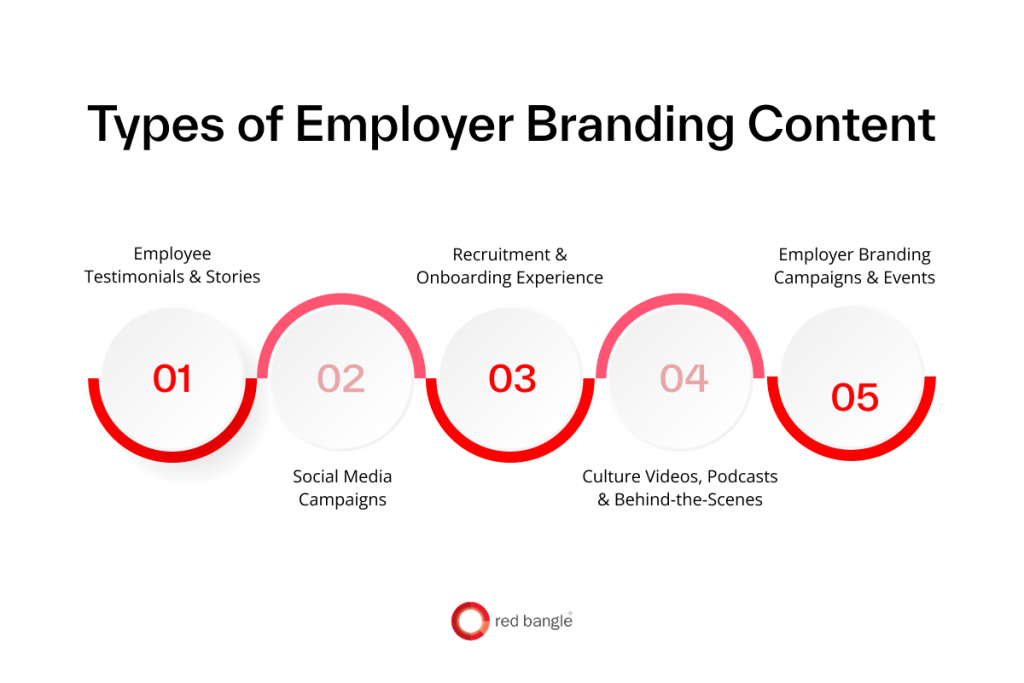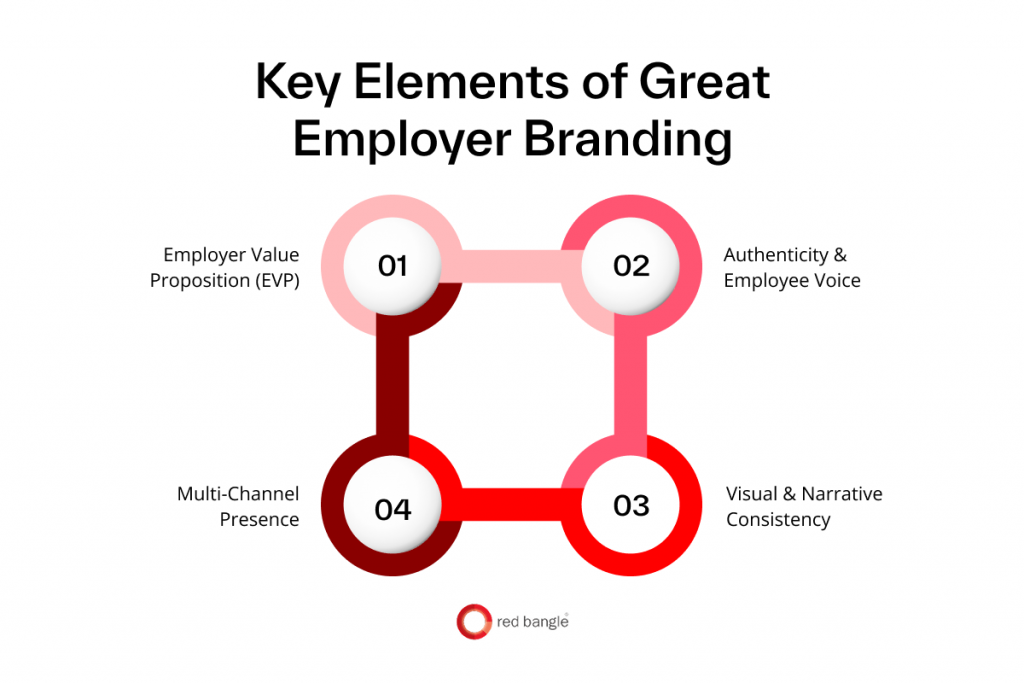Best Employer Branding Campaigns Examples 2026
See how leading brands turn culture into a talent magnet. This 2025 roundup breaks down standout employer branding examples, leadership storytelling, employee-led videos, and AI-powered campaigns, and shows what to copy, where to deploy it, and how to measure ROI across the funnel.

Introduction
It takes just seven seconds for a candidate to decide whether your job ad feels right.
Seven!
In that brief pause between scrolling and clicking, they are not only judging the role but also the heartbeat of your company.
Was the language human or robotic?
Did the design feel alive or outdated?
Did the message hint at a workplace built for growth, or just another cog in the machine?
These small, often overlooked details shape the first impression of your employer brand.
However, that impression does not come only from job ads. It is built in dozens of micro-moments: when an employee shares a behind-the-scenes photo on LinkedIn, when a candidate scrolls through Glassdoor reviews, or when a team win goes viral on social media. Each of these leaves a trace and adds to the story people believe about your workplace.
In this blog, we will explore the best employer branding examples from companies that have mastered those moments. You will see how they turned culture into content, values into magnetism, and stories into powerful recruitment tools you can learn from.
Top Employer Branding Examples
Employer branding examples show how companies attract and retain talent through authentic campaigns, career pages, and employee stories. Strong examples highlight clear EVPs, pay transparency, and workplace culture across channels like LinkedIn and Glassdoor.
Additionally, effective branding uses video, testimonials, and social content to prove trust, purpose, and flexibility, and prove impact through metrics like application rates, retention, and ROI.
In fact, the urgency is clear: global engagement slid to just 21% in 2024, with manager engagement at 27%. Gallup estimates that disengagement created a $438B productivity drag that year, making employer brand, culture, and storytelling business-critical levers for attraction and retention.
Since real results are easier to grasp when we see them in action, below is a curated set of professional employer branding examples that use leadership storytelling, employee voice, and platform-native formats to build trust with talent.
1. Infosys EB Leadership Series
Overview & Campaign Story
The Infosys EB Leadership Series was created to highlight the journeys of global leaders within the company. Anchored in the employer brand proposition “Move Forward. Take The World With You,” the series showcases leaders across geographies, emphasizing growth, inclusivity, and collaboration.
One episode features Jens Nullmeyer, Associate VP and Sales Head for Manufacturing in Europe, who reflects on his 12-year journey from business development manager to regional leader. The campaign reinforced Infosys’s commitment to fostering careers and empowering leaders to grow within the organization.
Creative Approach
At Red Bangle, we designed this series to feel less like corporate messaging and more like personal storytelling. The videos combine cinematic visuals, candid interviews, and regional context, creating an authentic narrative that resonates with both internal and external audiences. The storytelling emphasizes not just career progression but the culture of mentorship and collaboration that drives long-term success at Infosys.
Why It Worked
- Humanized leadership by putting faces and stories behind corporate titles.
- Aligned with Infosys’s EVP, ensuring consistency between brand promise and employee experience.
- Showed global inclusivity by featuring leaders from different regions and backgrounds.
Key Takeaway for Readers
If you are exploring employer branding in propositions, invest in leadership storytelling. Start with a strong EVP, then show how it comes alive through real people, in real contexts, with stories that resonate across markets.
2. AI-Powered Singalong and Face Swap Campaign
Overview & Campaign Story
For a Fortune 500 client with a 300,000-strong global workforce, we built an AI-led employee engagement initiative that turned a brand anthem into a participatory moment. The AI-powered singalong and face-swap videos campaign invited employees to watch a music video on a dedicated site and then jump in themselves, creating a personalized version in seconds.
This became one of the most shareable employer branding campaign examples, sparking organic buzz across internal channels and social.
Creative Approach
We composed an original campaign song, filmed employees grooving to it, and then custom-built an AI face-swap web app integrated into the campaign site. Employees chose a face from the video, snapped a selfie, and instantly watched themselves “sing” the anthem, lowering barriers to participation and making the experience delightful at scale.
Why It Worked
- Turned passive viewers into creators, driving deeper emotional connection.
- Showcased the company’s innovation through an on-brand AI experience.
- Sparked sharing and chatter as employees posted their clips, creating a strong employer branding example.
Key Takeaway for Readers
Interactive formats, especially lightweight AI-powered ones, can supercharge participation and internal advocacy. If you are looking for employer branding strategy examples that scale, pair a simple creation flow with a unifying cultural hook, such as a song, ritual, or inside joke, and make sharing frictionless.
3. Hotel Superhero – Treebo
Overview & Campaign Story
Treebo wanted to inspire pride and belonging among its hotel staff, many of whom play critical roles but often remain invisible in branding. The Hotel Superhero campaign flipped the spotlight, celebrating everyday employees as the true heroes of the brand.
Through powerful storytelling, the films captured how staff transformed guest experiences in ways that defined Treebo’s promise of quality stays. By centering the campaign on its people, Treebo turned internal recognition into an external talent magnet.
Creative Approach
At Red Bangle, we designed a narrative-driven film that presented hotel employees as everyday superheroes. Using dynamic visuals, personal stories, and authentic settings, we elevated the work of staff into inspiring moments of pride. The creative direction emphasized emotion and relatability, helping Treebo position itself as a people-first employer in the competitive hospitality sector.
Why It Worked
- Elevated frontline employees into brand ambassadors.
- An authentic, human-first tone resonated with both internal teams and job seekers.
- Strengthened Treebo’s positioning as a brand that values people as much as customers.
Key Takeaway for Readers
This is one of the best examples of employer branding campaigns rooted in inclusion. When you highlight unsung heroes inside your organization, you not only motivate employees but also show prospective talent that recognition is part of your culture.
4. Darwinbox – Employee Advocacy Campaign
Overview & Campaign Story
Darwinbox, a fast-growing HR tech company, needed to strengthen its image as an aspirational workplace for top talent. The campaign showcased employees as innovators working toward a shared mission of reimagining human resources for modern organizations.
By positioning employees as the heroes of the story, Darwinbox emphasized that working there means shaping the future of work.
Creative Approach
Together with Red Bangle, the campaign was built around authentic voices and vibrant storytelling. Employees across functions shared their personal experiences, while visuals highlighted the culture of collaboration and innovation. The creative style was fast-paced and modern, reflecting the energy of a tech company that is scaling globally.
Why It Worked
- Positioned Darwinbox as a forward-looking workplace with a strong mission
- Showcased employee passion as central to the company’s growth
- Reinforced the link between product innovation and employee experience
Key Takeaway for Readers
If you are looking for case studies of employer branding built on authenticity, empower employees to be your storytellers. Candidates trust real voices more than polished slogans, and advocacy-driven campaigns scale naturally when employees are proud to share their own journeys.
5. Zyeta
Overview & Campaign Story
Zyeta, a workplace design and architecture firm, wanted to highlight how its culture and people shape the innovative spaces it creates for clients. The campaign aimed to strengthen Zyeta’s employer brand by showcasing the authentic voices of its employees.
Rather than focusing solely on completed design projects, the storytelling emphasized what drives the team and how their creativity translates into meaningful workplace experiences.
Creative Approach
Red Bangle produced a film built around candid employee interviews and workplace interactions. The team avoided scripted delivery and leaned into genuine reflections from employees about their roles and growth within Zyeta. By blending personal stories with visuals of Zyeta’s vibrant office spaces, the campaign positioned the company as a culture-first employer where creativity and collaboration thrive.
Why It Worked
- Positioned Zyeta as a culture-driven workplace design leader
- Used real spaces and employee experiences to add authenticity
- Connected employer branding with the company’s core business of creating inspiring work environments
Key Takeaway for Readers
Employer branding examples like Zyeta show how organizations can link their value proposition directly to their core service or product. When your work improves employee lives, letting people experience it through storytelling strengthens both your employer brand and your business brand.
6. Infosys “Know Your Recruiter” Series
Overview & Campaign Story
Infosys recognized that recruitment can feel intimidating for candidates, especially when the process seems faceless or formal. To change this perception, the company launched the “Know Your Recruiter” series, which introduced recruiters as approachable professionals who care about the candidate journey.
By sharing their stories and perspectives, recruiters offered transparency and broke down common myths about interviewing at Infosys.
Creative Approach
At Red Bangle, we produced short films that presented recruiters in candid, human-centered ways. Each recruiter shared their journey, their approach to talent engagement, and what they value in candidates. The creative focus was on making recruiters relatable and approachable, breaking down barriers between candidates and the company.
Why It Worked
- Humanized recruiters and made them more accessible to potential candidates
- Reinforced Infosys’s EVP of inclusivity and growth
- Built trust in the recruitment process by creating transparency
Key Takeaway for Readers
Employer branding in recruitment works well when they show the people behind the hiring process. Introducing recruiters as real individuals creates a more personal, welcoming experience for candidates.
7. CoLearn
Overview & Campaign Story
CoLearn, an online learning platform in Indonesia, wanted to communicate its mission of transforming STEM education by empowering passionate educators. The campaign film was designed to inspire other teachers to join the movement by showing how CoLearn helps them evolve their teaching practices. At its heart, the story follows Yuna, a teacher who discovers new ways to unlock student curiosity through CoLearn’s tools and support.
Creative Approach
The film showcased Yuna’s journey as she integrated interactive quizzes, visual aids, and social media filters into her lessons. With CoLearn’s backing, her teaching went beyond formulas and equations to spark confidence and joy in her students. Red Bangle managed the project end-to-end, from teacher pre-interviews and scripting to visualization and on-ground coordination. The team also created a parallel film in Singapore to expand the campaign’s reach, ensuring consistency across different regions.
Why It Worked
- Presented education as an inspiring, technology-enabled journey
- Elevate teachers as heroes who spark curiosity and confidence
- Built credibility by blending storytelling with practical classroom innovation
Key Takeaway for Readers
Employer branding ideas succeed when they align purpose with storytelling. CoLearn’s campaign showed how celebrating educators and their impact can strengthen both recruitment and advocacy in the education sector.
8. Infosys Women’s Day Campaign
Overview & Campaign Story
To celebrate International Women’s Day, Infosys wanted to highlight the voices of women across its workforce and reinforce its commitment to diversity and inclusion. The campaign moved beyond generic greetings by putting women employees at the center, showcasing their achievements, stories, and perspectives. It gave visibility to women in different roles and emphasized how inclusivity is part of Infosys’s identity.
Creative Approach
Red Bangle produced a film featuring multiple women from Infosys speaking candidly about their experiences, challenges, and successes. The narrative was kept simple and authentic, letting their words drive the story while visuals captured them in relatable professional and personal settings. This human-centered approach ensured the focus stayed on the women themselves rather than on the company as a corporate entity.
Why It Worked
- Aligned with a global cultural moment while staying authentic to the company’s values
- Elevated employee voices, which created resonance and relatability
- Reinforced Infosys’s employer brand proposition as a workplace that empowers women and values inclusivity
Key Takeaway for Readers
Employer branding content resonates most when it reflects real people and values. Campaigns tied to cultural moments, such as International Women’s Day, become impactful when companies use them to amplify employee stories rather than broadcast generic messages.
At Red Bangle, we specialize in creating compelling employer branding campaigns that reflect your company’s culture and values.
We work with a global network of creatives, allowing us to deliver high-quality content tailored to your brand’s unique voice and recruitment goals. Whether you need a dynamic video series or a social-first campaign, our platform facilitates seamless collaboration, enabling brands to connect with top talent in a powerful and engaging way.
Our patent-pending creative cloud platform streamlines the entire creative process, from concept to delivery, ensuring fast, efficient production that meets deadlines while maintaining quality.
You can talk to our team to know how we can help you create such employer branding content for your business.
Types of Employer Branding Content

Employer branding works best when we mix formats that meet candidates at different moments in their journey. Below are the types of employer branding content we lean on most, with real employer branding examples from the set above folded in to show how each format comes alive.
1. Employee Testimonials & Stories
When employees speak in their own words, candidates lean in. Testimonial films make culture tangible and create some of the best examples of employer branding because they feel honest and specific. Our Zyeta film centers on candid employee reflections to show how creativity and collaboration actually happen, while CoLearn follows a teacher’s story to spotlight purpose and impact in education.
How to make them work
- Keep narration unscripted and first person, then edit for clarity and pace
- Capture real moments that show growth, mentorship, and belonging
- Version long cuts into shorts for LinkedIn, YouTube, and your careers hub
2. Social Media Campaigns
Social-first series and UGC prompts turn employees into co-creators. These are the most visible employer branding social media examples because they travel fast and feel native. The AI-powered Singalong and Face Swap turned a brand anthem into a participatory moment employees loved to share, and Infosys Women’s Day generated heartfelt shoutouts that moved naturally across feeds.
Flexibility is now a visible brand signal too. LinkedIn data shows employers perceived as flexible are 29% more likely to receive an application and 16% more likely to see outreach accepted.
Plays that travel well
- Short, themed series with a consistent hook and clear call to participate
- Employee takeovers and reels that highlight culture cues and small wins
- A simple link path from post to role or culture page for conversion
3. Recruitment & Onboarding Experience
Your pipeline is part of the brand. Clear expectations and human touchpoints become powerful employer branding in recruitment examples.
Reviews heavily influence this stage. 4 in 5 candidates consult company ratings, and many read 7 or more reviews before forming an opinion.
Infosys’ “Know Your Recruiter” puts approachable faces to the process and builds trust, while Darwinbox frames joining as a growth journey that starts strong on day one.
Where to focus
- Publish “how we hire” guides, recruiter intros, and interview prep checklists
- Write transparent JDs with scope, must-haves, and growth paths
- Turn onboarding into a story with welcome films and a 30-60-90 plan
4. Culture Videos, Podcasts & Behind-the-Scenes
This lane proves the promise. Employer branding videos like culture films, pods, and BTS sequences become living examples because they show values in action. The Infosys EB Leadership Series connects leadership journeys to the EVP, and Zyeta’s behind-the-scenes moments reveal how teams create together, not just what they create.
Make the EVP tangible
- Film recurring rituals and cross-team collaboration to show how work really happens
- Pair a polished hero film with lo-fi BTS for authenticity and contrast
- Keep a narrative spine so episodes compound into a recognizable story
5. Employer Branding Campaigns & Events
Big moments create momentum. Seasonal campaigns, DEI spotlights, and launches are memorable employer branding campaign examples when they elevate employee voices. Infosys Women’s Day aligns values with a cultural moment, and Treebo Hotel Superhero rallies talent around a mission and product story during a pivotal scale phase.
Turn moments into movement
- Anchor each moment to a clear value, then amplify through employee stories
- Build a modular toolkit, from hero film to shorts, stills, and captions
- Measure reach, engagement, applications, and referrals to learn and iterate
Also read → Tips to make landing pages less boring with videos
Key Elements of Great Employer Branding Strategy

Successful campaigns, regardless of format, share a few core elements. Here is what makes them stand out in practice.
1. Employer Value Proposition (EVP)
Your EVP is the promise we make to employees and the proof we show every day. It should be simple, specific, and visible in real moments of work, not only on a slide.
Randstad’s 2024 global research shows the EVP drivers that matter most: attractive pay and benefits, work–life balance, job security, and a pleasant work atmosphere. Anchoring campaigns in these levers ensures the promise resonates.
The above-mentioned Infosys EB Leadership Series does this well by connecting career growth and global belonging to a clear promise, then letting leaders demonstrate how that promise shows up in their journeys.
That is how an EVP moves from words to lived experience and becomes one of our most persuasive employer brand proposition examples.
Make it work
- Boil the promise down to one sentence that maps to programs and behaviors
- Keep language human, specific, and testable so it guides decisions
- Show the EVP inside real moments of work, not only in copy
To ensure your EVP stays relevant, consider implementing real-time feedback loops, such as quarterly surveys or focus groups, where employees share their experiences. This allows you to adjust your messaging based on real, up-to-date insights.
2. Authenticity & Employee Voice
Candidates trust employees more than brands. When we center real voices, the message feels honest and useful.
The above example of Zyeta leans on candid interviews to reveal culture, CoLearn follows a teacher’s journey to show purpose in action, and Infosys’ “Know Your Recruiter” puts approachable faces to hiring.
Each piece lets employees speak in their own words, which is why these are great employer branding examples for credibility.
Make it work
- Capture unscripted conversations, then edit for clarity and pace
- Show everyday decisions that reflect values, not just big wins
- Invite multiple perspectives across teams and tenures
Employer branding isn’t just about external communication; it also involves a strong internal culture. Erka Amursi, the principal researcher in the Human Capital Center at The Conference Board, reinstates this by saying:
“It’s about culture. It’s about communication internally with everybody, and about how interesting the job is. And it may be about the meaningfulness of the job, the main values, the mission that you are trying to achieve by working for that organization.”
3. Visual & Narrative Consistency
Consistency helps people recognize us and remember what we stand for. It also improves performance because every asset reinforces the same story.
For example, the Infosys Women’s Day film and the EB Leadership Series share a steady tone and look, while Treebo Hotel Superhero links founder stories, product vision, and talent appeal inside one narrative.
When the system is consistent, every asset reinforces the whole and becomes one of the best examples of employer branding in practice.
Make it work
- Define a simple narrative spine that ties back to the EVP
- Use a shared visual kit across career site, videos, ads, and internal comms
- Keep recurring cues like typography, music motifs, and opening beats
4. Multi-Channel Presence
Great stories travel across formats and moments. Designing for multiple channels ensures candidates receive the same message wherever they are.
The AI-powered Singalong and Face Swap made participation easy on a campaign site and then spread through internal channels and social. Women’s Day clips worked on LinkedIn and inside employee communities.
A multi-channel system lets people discover us where they already are, which turns interest into action and strengthens successful talent branding.
Make it work
- Plan the journey from hero film to reels, stories, job ads, and the careers hub
- Tie social posts and media back to roles or culture pages for conversion
- Measure reach, saves, applications, and referrals to improve over time
At Red Bangle, we blend creative storytelling with measurable outcomes so employer branding drives brand recall and better talent quality, not just views. Here’s what we bring:
- Video-first storytelling and campaign execution that brings employer brands alive visually. We act as a strategic partner, not just a production vendor.
- Full-stack creative across film, video, design, AI, and immersive experiences, built to scale across regions and channels.
- Measurement frameworks from day one. We link campaigns to business KPIs such as awareness, candidate quality, retention, and social engagement.
Teams that want a bold, campaign-driven lift to their employer brand with creativity and accountability in equal measure can talk to our experts and get the free consultation tailored to their brand.
Also read → Know 6 ways to create engaging storytelling videos for lasting impact and recall
We walked through real employer branding examples, the types of employer branding content that convert attention into applications, and the core elements that make your promise believable. Your next move is simple and focused.
Here is a focused 30-day plan:
- Week 1: Audit touchpoints against your EVP and choose one format to ship.
- Week 2: Script, source employee voices, and build a simple toolkit of hero, shorts, stills, and captions.
- Week 3: Produce and set tracking for apply rate, offer acceptance, referral rate, and brand search.
- Week 4: Publish, respond to comments, review results, and iterate. Systemize what works so every new asset compounds across channels.
If you want a partner to turn your EVP into campaigns with creative craft and measurable outcomes, book a call with Red Bangle today.
What story will you ship next?



